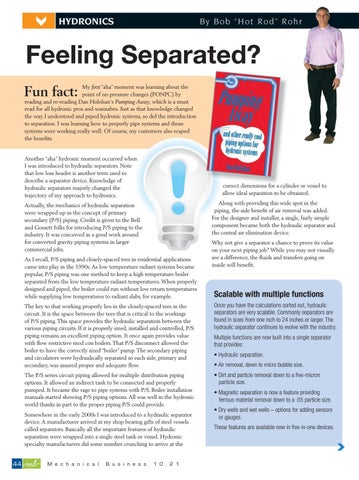HYDRONICS
B y B o b “ Ho t R o d ” R o h r
Feeling Separated? Fun fact:
My first “aha” moment was learning about the point of no pressure changes (PONPC) by reading and re-reading Dan Holohan’s Pumping Away, which is a must read for all hydronic pros and wannabes. Just as that knowledge changed the way I understood and piped hydronic systems, so did the introduction to separation. I was learning how to properly pipe systems and those systems were working really well. Of course, my customers also reaped the benefits. Another “aha” hydronic moment occurred when I was introduced to hydraulic separators. Note that low loss header is another term used to describe a separator device. Knowledge of hydraulic separators majorly changed the trajectory of my approach to hydronics.
correct dimensions for or vessel to d f a cylinder li allow ideal separation to be obtained. Along with providing this wide spot in the piping, the side benefit of air removal was added. For the designer and installer, a single, fairly simple component became both the hydraulic separator and the central air elimination device.
Actually, the mechanics of hydraulic separation were wrapped up in the concept of primary secondary (P/S) piping. Credit is given to the Bell and Gossett folks for introducing P/S piping to the industry. It was conceived as a good work around for converted gravity piping systems in larger commercial jobs. As I recall, P/S piping and closely-spaced tees in residential applications came into play in the 1990s. As low temperature radiant systems became popular, P/S piping was one method to keep a high temperature boiler separated from the low temperature radiant temperatures. When properly designed and piped, the boiler could run without low return temperatures while supplying low temperatures to radiant slabs, for example.
Scalable with multiple functions
The key to that working properly lies in the closely-spaced tees in the circuit. It is the space between the tees that is critical to the workings of P/S piping. This space provides the hydraulic separation between the various piping circuits. If it is properly sized, installed and controlled, P/S piping remains an excellent piping option. It once again provides value with flow restrictive mod con boilers. That P/S disconnect allowed the boiler to have the correctly sized “boiler” pump. The secondary piping and circulators were hydraulically separated so each side, primary and secondary, was assured proper and adequate flow.
Once you have the calculations sorted out, hydraulic separators are very scalable. Commonly separators are found in sizes from one inch to 24 inches or larger. The hydraulic separator continues to evolve with the industry.
The P/S series circuit piping allowed for multiple distribution piping options. It allowed an indirect tank to be connected and properly pumped. It became the rage to pipe systems with P/S. Boiler installation manuals started showing P/S piping options. All was well in the hydronic world thanks in part to the proper piping P/S could provide.
• Dirt and particle removal down to a five-micron particle size.
Somewhere in the early 2000s I was introduced to a hydraulic separator device. A manufacturer arrived at my shop bearing gifts of steel vessels called separators. Basically all the important features of hydraulic separation were wrapped into a single steel tank or vessel. Hydronic specialty manufacturers did some number crunching to arrive at the 10 44
Why not give a separator a chance to prove its value on your next piping job? While you may not visually see a difference, the fluids and transfers going on inside will benefit.
M e c h a n i c a l
B u s i n e s s
1 0 . 2 1
Multiple functions are now built into a single separator that provides: • Hydraulic separation. • Air removal, down to micro bubble size.
• Magnetic separation is now a feature providing ferrous material removal down to a .05 particle size. • Dry wells and wet wells – options for adding sensors or gauges. These features are available now in five-in-one devices.


